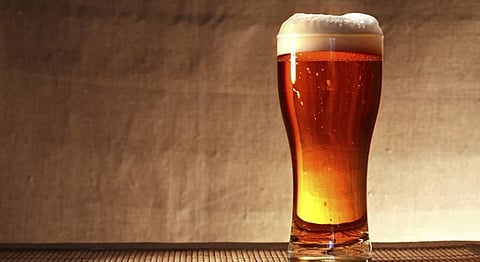
- HOMEGROWN WORLD
- #HGCREATORS
- #HGEXPLORE
- #HGVOICES
- #HGSHOP
- CAREERS
- ABOUT US
- CONTACT US

The Brits are sticklers about a few specific things, one being a proper pint. Now they had no issue ravaging India for its wealth and generally being racist, colonial paraquats, but they did have an issue with a lack of their favourite libation, Porters. Porters are tailormade for dreary English weather, and I must say when your upper lip meets the soft, frothy head of well-made Porter on a cold day in the UK, well, it just works.
However, the rosy cheeked colonizers had a huge issue transporting their Porter on the six month journey to India. The brew often went bad during the journey, which was an expensive waste, and a heartbreaking reality for the many alcoholic sailors that manned the ships. Moreover, the casks that survived the journey hardly quenched the thirst of her majesty’s loyal servants trespassing in the ‘tropics’.
You see Porters are best enjoyed during an English Autumn, a creamy head that leaves a thick clinging lace as the roasty tones of the pint cut through brisk weather. Even Mark Dredge of The Guardian waxs poetic for Porters, “Autumn brings something darker, auburn like the leaves, toffee and bonfire flavours, earthy and spicy.” He further suggests the perfect pint for September to be a Smoked Porter, “warming like a pub fire.”
In our humble opinion Porters and India only make sense in the cooler, northern parts of the country or in a barroom that is heavily air conditioned. Given that in the days of the East India Company transportation of cask beer to the north was not feasible and the concept of air conditioning obviously did not exist, Porter had no place in the Sub-Continent. Thus, the khaki-clad fellows of the East India Company remained parched for a good pint and continued their role as movable sweat stains in the toasty Indian sun.
As you can imagine they were pretty desperate, so the British Army and the East India Company had a few stern words for Hodgson, their main supplier of Porter, urging him to rectify this distressing issue. While the Army and East India Company tried to build mobile breweries on their ships, and failed rather miserably, according to The Smithsonian, “Hodgson tried unfermented beer, adding yeast once it arrived safely in port. They tried beer concentrate, diluting it on shore. Nothing worked. Nothing, that is, until Hodgson offered, instead of porter, a few casks of a strong, pale beer called barleywine or ‘October beer’.”
He basically added an increased amount of hops and sugar to the October Ale or Pale Ale. Any forum for homebrewers, in this case Kegerator, will attest to the fact that, “a popular method for increasing the ABV (Alcohol by volume) of an existing beer recipe without bringing much change, is to simply add more sugar into the mix”; in addition, “Generally, the higher the alcoholic content of a drink, the more forgiving the drink is going to be,” says Bart Springer to The Morning Call. Springer explains that in most cases the higher the alcohol content, the better the chance a beverage’s quality will be stable, even when stored in conditions that are unideal.
Moreover, the incorproation of more hops better protected the quality of the beer over the long jouney over sea. As the Denis De Keukeleire, of the Faculty of Pharmaceutical Sciences at the University of Gent, explains, “hops sterilize the wort solution (the sugar solution after filtration), which takes care of the bacteriological stability of beer”.
Thus, the beer whose name was coined after its ultimate destination, India, was a crisp beer whose citrus tones, from the hops, could actually refresh England’s lads wilting away like beleaguered geraniums in the Far East. The Brits lucked out with their modified Pale Ale, a beer that not only could survive the long journey, but actually suited the climate better.
Allegedly an 1822 edition of the Calcutta Gazette read:
“Hodgson’s warranted prime picked ale of the genuine October brewing. Fully equal, if not superior, to any ever before received in the settlement.”
Record varies on how popular this method of brewing was before it was discovered as a suitable beer for extended nautical travel, however, it undeniably became quite a bit more popular after this discovery was made. However, the Brits finally had to say goodbye to their beloved India, the only sad part of their long overdue exodus being that India’s namesake Ale left with them.
Fastforward to the early 21st century and British brewing is in bad shape, its market congested with cheap, conglomerate lager and IPA is nowhere to be found in India. Then the great American Micro-Brew Renaissance (this is not an official term, but it sure felt like a Renaissance to us) kicked in, a glorious chance for the Yanks to shame the Union Jack colonial style.
The rekindled love for brewing is one of the few hypes from America that actually resulted in the betterment of humanity, as it kickstarted a craft brewing fever around the world. That’s why close to a decade ago in India the grumblings of vitually any beer drinker who’d been abroad shook the heavens as prayers pelted paradise for any beer other than cheap, canal piss (a loving term for Heineken) lager. Then good ol’ Doolally Taproom came as a godsend answer, the fruition of India’s first Micro-Brew Pub in Pune.
Now getting India’s namesake Pale Ale is a much easier task, as most metrepolitan cities have several watering holes where beer drinkers can wet their whistle with a refreshing IPA. Nevertheless, we spoke to Pankil Shah the craft beer curator of Woodside Inn and brewmaster Anand of BrewBot to get their opinion on how IPA, and craft beer in general, is doing in the Indian market. Check out their interview next week.
